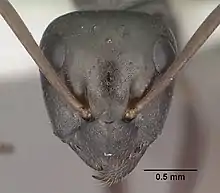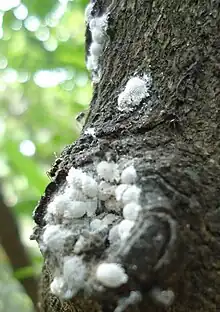Formica fusca
Formica fusca is a black-colored ant commonly found throughout Europe as well as parts of southern Asia and Africa.[1] It has the common names silky ant or dusky ant. The range within the palaearctic region extends from Portugal in the west to Japan in the east and from Italy in the south to Fennoscandia in the north. Populations from North America have been split off as a separate species, Formica subaenescens.[2] F. fusca nests are usually found in rotten tree stumps or under stones in clearcut areas and along woodland borders and hedgerows.
| Formica fusca | |
|---|---|
.jpg.webp) | |
| Scientific classification | |
| Domain: | Eukaryota |
| Kingdom: | Animalia |
| Phylum: | Arthropoda |
| Class: | Insecta |
| Order: | Hymenoptera |
| Family: | Formicidae |
| Subfamily: | Formicinae |
| Genus: | Formica |
| Species: | F. fusca |
| Binomial name | |
| Formica fusca | |
Eusociality
Colonies are facultatively polygynous (though weakly so, with a mean number of queen of 3.09[3]); though the queens coexist amicably, contribution to the brood tends to be unequal. Nests are usually small, containing 500–2,000 workers. The workers are large, at 8–10 millimetres (0.3–0.4 in) long, and fast moving, though timid. To ensure that non-nest mate eggs are not reared, these workers will engage in a process known as worker policing. Alate (winged) forms are produced in June/July and nuptial flights are in July/August.
A study has found evidence of nepotism in F. fusca,[4] in contrast with previous experiments with other ant species;[5] this conclusion has been challenged on the grounds that the observed pattern may result from differences in egg viability.[6]
Ecology

F. fusca feeds on small insects such as codling moth larvae, aphid honeydew and extrafloral nectaries. Workers have been found to have a very high resistance to some pathogens[7] and it is thought this may be due to F. fusca utilising the antibiotic properties of their formic acid, additional to the use of their metapleural gland. The larvae of Microdon megalogaster, a member of the ant fly genus, have been observed in the nests of these ants. The inquiline relationship of these fly larvae is not well understood.[8] [9]
Behaviour

Workers of this ant species can learn to associate an olfactory stimulus to a reward (sugar solution) during a classical conditioning protocol. Ants are fast to learn, and only a single presentation of the stimulus is enough for them to form a genuine long-term memory. This formed memory is also resistant to extinction.[10]
The learning abilities of this species were tested using single compounds found in flower emission.[10] Ants of this species can also detect volatile organic compounds emitted by cancer cells.[11] After a 3-trial conditioning, they can differentiate cancer cell lines (MCF-7) from healthy ones (MCF-10A). They can also discriminate one cell line (MCF-7) from another cancerous one (MDA-MD-231).
References
- "Species: Formica fusca Linnaeus, 1758". AntWeb. California Academy of Sciences. 2018. Retrieved 1 February 2018.
- Schär S, Talavera G, Espadaler X, Rana JD, Andersen Andersen A, Cover SP, Vila R (August 2018). "Do Holarctic ant species exist? Trans‐Beringian dispersal and homoplasy in the Formicidae". Journal of Biogeography. 45 (8): 1917–1928. doi:10.1111/jbi.13380. S2CID 51832848.
- Bargum K, Helanterä H, Sundström L (July 2007). "Genetic population structure, queen supersedure and social polymorphism in a social Hymenoptera". Journal of Evolutionary Biology. 20 (4): 1351–1360. doi:10.1111/j.1420-9101.2007.01345.x. PMID 17584230. S2CID 42946143.
- Hannonen M, Sundström L (February 2003). "Sociobiology: Worker nepotism among polygynous ants". Nature. 421 (6926): 910. Bibcode:2003Natur.421..910H. doi:10.1038/421910a. PMID 12606988. S2CID 4332432.
- Snyder LE (September 1993). "Non-random behavioural interactions among genetic subgroups in a polygynous ant". Animal Behaviour. 46 (3): 431–439. doi:10.1006/anbe.1993.1212. S2CID 53144635.
- Fournier D, Aron S, Keller L (January 2004). "Significant reproductive skew in the facultatively polygynous ant Pheidole pallidula" (PDF). Molecular Ecology. 13 (1): 203–10. doi:10.1046/j.1365-294x.2003.02036.x. PMID 14653800. S2CID 5909680.
- Graystock P, Hughes WO (2011). "Disease resistance in a weaver ant, Polyrhachis dives, and the role of antibiotic-producing glands". Behavioral Ecology and Sociobiology. 65 (12): 2319–2327. doi:10.1007/s00265-011-1242-y. S2CID 23234351.
- Curran, Charles Howard (1925). "Contribution to a monograph of the American Syrphidae north of Mexico". The Kansas University Science Bulletin. 15: 7–216.
- Heiss, Elizabeth Madeleine (1938). "A classification of the larvae and puparia of the Syrphidae of Illinois exclusive of aquatic forms". Series: Illinois biological monographs. 16: 1–142.
- Piqueret B, Sandoz JC, d'Ettorre P (June 2019). "Ants learn fast and do not forget: associative olfactory learning, memory and extinction in Formica fusca". Royal Society Open Science. 6 (6): 190778. Bibcode:2019RSOS....690778P. doi:10.1098/rsos.190778. PMC 6599790. PMID 31312508.
- Piqueret B, Bourachot B, Leroy C, Devienne P, Mechta-Grigoriou F, d'Ettorre P, Sandoz JC (March 2022). "Ants detect cancer cells through volatile organic compounds". iScience. 25 (3): 103959. Bibcode:2022iSci...25j3959P. doi:10.1016/j.isci.2022.103959. PMC 8914326. PMID 35281730.
Further reading
- Collingwood CA (1979). The Formicidae (Hymenoptera) of Fennoscandia and Denmark. Fauna Entomologica Scandinavica. Vol. 8. Klampenborg, Denmark: Scandinavian Science Press. ISBN 978-1-340-08341-0.
- Czechowski W, Radchenko A, Czechowski W (2002). The Ants (Hymenoptera, Formicidae) of Poland. Warsaw: Museum and Institute of Zoology, Polish Academy of Sciences. ISBN 83-85192-98-0.